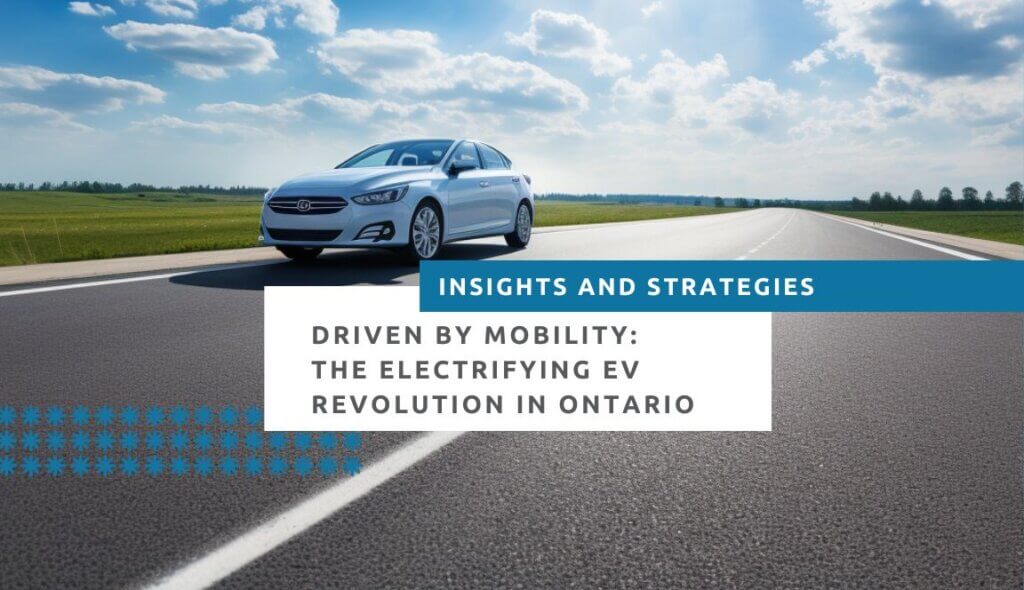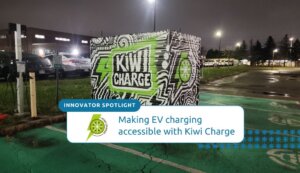Welcome back to another edition of Driven by Mobility, where we explore CITM’s five areas of focus. As you have probably guessed, this article is about Ontario Electric vehicles (EV’s)!
Imagine driving a car that’s efficient, stylish, and eco-friendly. Well, that’s the direction the sector is headed. Right now, we’re seeing big changes in how cars are made and run. This is thanks to electric vehicles and new technologies that don’t rely on traditional gas. As we all become more concerned over climate change and air pollution, the shift towards cleaner transport is not just a trend—it’s a necessity. In this article, we’ll explore the latest technologies, how these technologies are shaking up the transportation industry, and how people can work together to make greener roads. Let’s hit the road to the future of driving!
Ontario’s Ambitious Goals for the EV Market
Ontario, Canada, has aimed high with a goal of making 400,000 electric and hybrid vehicles by 2030, setting itself up to be a big player in the electric vehicle (EV) market. This isn’t just a big target to hit, but a clear signal of the province’s dedication to cleaner transport systems. It’s a bold step towards boosting the economy in a sustainable way, and lessening the environmental footprint of the car industry.
And it’s not just about sheer numbers. Behind the scenes, there’s a hub of innovation and forward-thinking strategies making this dream a reality. Ontario isn’t just aiming to make more EVs – it’s striving to make them better, more efficient, and more user-friendly.
Green Transportation Means a Surged Economy
As Ontario ramps up EV production, our roads will become much greener. This green shift is about more than helping the environment – it’s about supercharging our economy.
Why? Three reasons. First, people want electric vehicles, so companies making them stand to make a profit. Second, owning an electric vehicle costs less in the long run because they don’t need as much maintenance. And lastly, charging an electric car is cheaper than filling up with gas, especially here in Ontario.
Ontario is perfectly set up for this – we’ve got everything we need to make and power electric cars right here. We even have the potential to lead the way in using hydrogen fuel cells for bigger vehicles like trucks.
So, as we celebrate more electric cars on our roads, remember that this is also great news for our wallets and our future!
How electrifying transportation could surge Ontario’s economy
Ford’s Massive Investment in EV Manufacturing in Ontario
The first step to making EVs more available and efficient in Ontario is by investing in production. Thankfully, Ford Motor Co. has announced a $1.8 billion investment to transform its Oakville plant into a high-volume EV manufacturing hub. With construction starting in 2024, and vehicle production in 2025, the plant will be renamed to the “Oakville Electric Vehicle Complex”. This move shows Ford’s commitment is directly inline with Ontario’s: To build a greener tomorrow! Not only are they pushing for greener roads, but also contributing to the province’s economic growth.

Volkswagen’s Seven Billion Dollar Investment
The largest car maker, Volkswagen, will invest in Ontario to build a giant EV battery plant. The massive $7 billion dollar battery plant will be the largest auto investment in Canada! To be built in St. Thomas, Ontario, the plant will be established as VW’s first overseas battery plant. This decision promises to generate thousands of jobs and enhance Canada’s EV market. The plant will also source critical minerals from mines in northern Ontario, further boosting Ontario’s economy.
The Next Steps: Hydrogen Fuel Cells
With EV and EV battery production happening all in Ontario, what else could we hope for? The answer is Hydrogen.
Canadian EV maker, Trouvé Victory, is working with Trent University to make something even more exciting than EVs. Hydrogen fuel cell cars! With innovations such as AI cockpits and rooftop solar panels, Trouvé could lead Canada to an even greener path!
Once mass production rolls out in 2025, we can expect major economic growth, and diversification in consumer choice.
The best thing is, Trouvé’s commitment extends beyond production lines. They’re investing in our future work-force. Offering co-op placements for students, which could lead to fruitful careers in a rapidly growing sector.
The Expanding Reach of EVs in Ontario
While EVs have been making an impact on the personal vehicle market, their reach is now expanding to trucks, buses, and other forms of mobility.
Ontario is already on the move to implementing EVs in its public transportation, introducing two all-electric buses into its fleet in Toronto. Starting on May 15th, commuters can experience the all electric GO Buses for themselves. Even though they cost more than the usual diesel buses, they’re cheaper to run and last longer, which will save money over time.
“This is just the beginning,” said Ontario Premier Doug Ford. “The future is electric, and we’re going to lead the charge.”
The Rise of E-bikes in Sustainable Urban Transportation
Another form of EVs that we could see in our daily lives are electric bikes! E-bikes are becoming an increasingly popular choice for green urban mobility. Cities like Amsterdam, Oslo, and Guangzhou are embracing this mode of transportation to reduce carbon emissions, traffic congestion, and air pollution.
E-bikes are a convenient and eco-friendly alternative to traditional bicycles and motor vehicles. This makes them ideal for urban commuters who are looking to adopt more sustainable travel habits.
The Impact of Lower Mineral Prices on Electric Battery Production
Lithium, a key ingredient in batteries for EVs, has gotten a lot cheaper. Its price has dropped by over 65% since the start of the year.
This decrease in prices is actually good news for people who want to buy EVs. The cost of these cars could drop to around $25,000 to $40,000 as a result.
Companies like Sudbury-based Frontier Lithium see this as an opportunity. They believe there will be more demand for lithium as more EVs are made in Ontario. They’re hoping to supply lithium to car manufacturers in the future. So even though the journey might be a bit bumpy, the future looks bright for EVs and lithium.
Key Innovations to Look Out For
Besides the EV tech that we have covered, there are still more innovations coming out. Here’s a list of technologies you should keep an eye out for.
1. Battery Technology
Battery technology has been evolving at a rapid pace. We can expect to see more energy packed into smaller batteries, with faster charge times, at a cheaper rate. These advancements will help more households adopt EVs.
2. Electric Motors
Another aspect to keep an eye out for is the advancement in electric motors. Mercedes-Benz, Renault, and others are looking to enhance motor efficiency, which will help set the stage for the next leap in EV performance. However, this technology relies heavily on rare earth metals so companies like Volkswagen are looking for alternative ways to build their motors too.
3. Fuel Cell Systems
Fuel cell vehicles (FCVs) are a new type of electric vehicle that are powered by hydrogen, and could change how we travel. Instead of using batteries like traditional EVs, they create power from a chemical reaction between hydrogen and oxygen. The only thing they leave behind is water, making them really good for the environment. They can go further and fill up quicker than battery electric vehicles, which makes them a great choice for heavy vehicles and long trips.
4. Vehicle-to-Grid (V2G) Technology
Think of Vehicle-to-Grid technology as big batteries on wheels that can also give power back to the grid. When there’s a high demand for electricity, or not enough renewable energy being made, these cars can send their stored power back into the grid. This can help keep the lights on and even make money for electric vehicle owners. An example of this is the F-150 Lightning. If your house’s power goes out, you can plug this truck in and keep your home running for days!
5. Wireless Charging
In the future, charging your electric vehicle could be as simple as parking it. That’s thanks to wireless charging technology, which removes the need for any cords or plugs. This tech could make owning and charging an electric vehicle easier and more attractive. Just park and let it charge!

The Road Ahead
Turning to sustainable transportation isn’t just about cool tech, it’s a team effort. There’s a lot more work to be done, and everyone – from governments to businesses, and even you and me – can help speed things up.
As the 2021 Global EV Outlook publication recommends; Governments need to keep giving perks to electric vehicle makers and users. Things like tax breaks for the companies, and subsidies for those who buy these cars could help. Also, making certain urban areas low-emission zones could push more people to choose electric.
Companies can help too. By investing more in research, creating partnerships, and supporting the electric vehicle industry, they can speed up the switch to sustainable transport. Ford Motor Co. and Gatik are already doing great work, and it will be good to see more companies join in.
And of course, we as individuals can make a huge difference. By choosing electric vehicles for ourselves and our businesses, we can help reduce harmful emissions and help slow down climate change. So, let’s get on board with this journey to a cleaner future!
Charging Towards a Greener Future
We’ve come a long way in making vehicles greener. Technology has improved a lot in recent years, and it’s clear that it could change the way we travel. From Ontario’s big plans, to major private investments in EV manufacturing & production, plus the growth in electric options for all types of vehicles, it’s clear that sustainable transport has a bright future.
Other ‘Driven by Mobility’ Articles You May Find of Interest
We hope you enjoyed this article on electric vehicles. Driven by Mobility is an original series where we explore CITM’s five areas of focus. You can find all of them here.
You can also directly jump to each article:
About the Centre for Integrated Transportation and Mobility
The Centre for Integrated Transportation and Mobility (CITM) is an accelerator with everything your business needs to take electrified, connected and autonomous vehicle innovations from ideation to commercialization and scale-up. CITM will match you with industry, business development and technical expertise to help you find product-market fit, pilot projects, strategic connections, and growth opportunities. With CITM you can leverage exclusive R&D resources to test and validate your innovation through leading-edge test environments, technology platforms, rich datasets, and specialized labs.








